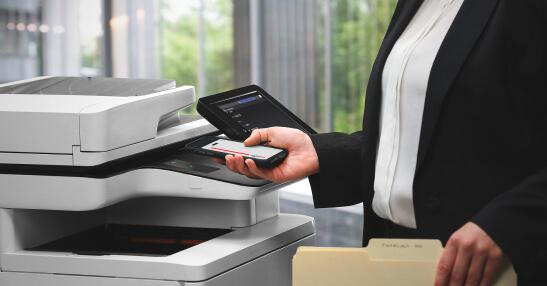How Secure Print Solutions Provide Peace of Mind to Financial Institutions
Speak With An Expert
Hola mundo alerta alerta
To protect valuable customer information, many financial institutions have embraced cutting-edge network security solutions and protocols. However, some targets (such as software portals or mobile devices) receive the lion’s share of attention, leaving other touchpoints more vulnerable.
Printers are one of these oft-forgotten targets. Failing to protect the security of their print infrastructure can be costly for businesses, with 68% reporting a data loss as a result of unsecured printing practices. To keep printers secure, financial institutions must invest in secure print solutions that ensure authorized-only printing to network-connected multifunction printers (MFPs) and provide an audit trail of every user’s interactions with the printer.
Secure print management solutions are a frictionless way for employees to access network-connected printers.
Typically, businesses have access to overall print usage but not the specific users who access these printers. For example, if an individual scans a balance sheet and sends it to an executive within the company directly from the copy machine, IT would be unable to see who sent the document. This blind spot is exactly what malicious actors are counting on.
On the other hand, a secure printing solution mobile-enabled for identity access authentication verifies that only authorized employees have access to the machine. It also logs every action in a centralized database, ensuring a comprehensive audit trail. As a result, financial institutions benefit from greater visibility into printer use and can prevent unauthorized print jobs. Requiring employees to badge in to release a print job also reduces paper waste, as they must be physically present at the printer to complete the job.
Secure printing is a useful investment for businesses across industries, but it’s vital for industries that deal with highly sensitive documents. Letting financial information into the wrong hands can lead to catastrophic reputational damage, financial losses and depleted customer trust.
Financial institutions must also navigate a gamut of compliance regulations related to protecting customer data. In Europe, the General Data Protection Regulation (GDPR) outlines a long list of obligations that data controllers must abide by. Some of these include the compliance of privacy management software, mobile banking software and other tools that financial institutions use. In the U.S., the Gramm-Leach-Bliley Act requires financial institutions to explain their information-sharing practices to their customers. Unsecured print management prevents financial institutions from meeting these requirements and leaves them open to fines and legal consequences.
Beyond security benefits, secure print solutions also help lower the day-to-day costs associated with using paper and ink. Documents that are sent to be printed but never picked up lead to unnecessary waste, which adds up over time. For financial institutions, both incremental costs and massive compliance fines are each worth avoiding.
Print solutions aren’t one-size-fits-all; what works for your organization may not be suitable for another. Before diving into implementation, you must understand what to look for. Here are three steps to take as you consider which secure print solution is right for you.
Your chosen print solution will differ depending on your objectives and industry. If you are less concerned with compliance fines or malicious attacks, an output management solution that helps save time and money on paper might be appropriate. But for industries with a high degree of fraud risk like financial services and insurance, an encrypted credential strategy supported by mobile-enabled card readers makes sense. This type of system requires users to authenticate their identity to access a network-connected MFP. For example, RFID readers such as the WAVE ID® SP Plus require users to use their badges to authorize print releases. These readers can also work in tandem with output management solutions to maximize both efficiency and security.
Upholding security shouldn’t mean sacrificing user experience. If your chosen touch-free secure print solutions can’t integrate with existing hardware and workflows, it will add undue friction to the printing process.
To avoid this, choose solutions that support your existing printer hardware and any solutions from independent software vendors (ISVs). Mobile readers, for example, can integrate seamlessly alongside your existing physical access credentials and security infrastructure. Preventing disruptions and unnecessary troubleshooting helps ensure no fraudsters slip through the cracks.
When evaluating print solutions, consider the importance of access control. Employees authorized to access and print sensitive information should be able to do so with ease, while users without authorization must be locked out. Additionally, leadership must have top-down visibility into the entire network, including the ability to see who has accessed a given device. Your access control solution should also make it simple to adjust permissions as necessary.
With new threats continuing to emerge and the price of non-compliance continuing to rise, you can’t afford unsecure printing. To keep sensitive information safe, invest in secure print solutions that provide greater levels of visibility and access control.
Reach out to rf IDEAS to learn more about how secure print solutions can provide your organization peace of mind.